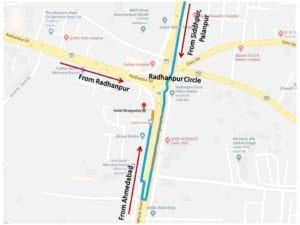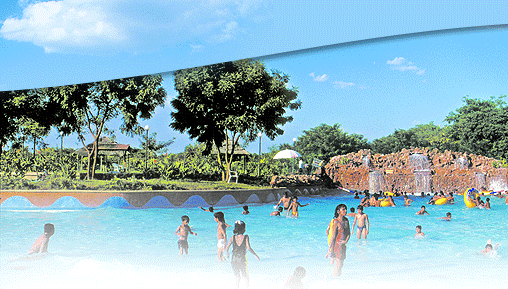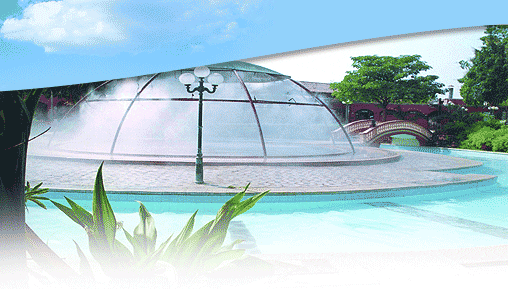The Water Park near Mehsana city is the most attractive tourist place. It is 15 kms from Bhagyoday Hotel Mehsana.
Water Park Mehsana is India’s first and Eurasia’s biggest water park in mehsana city. The Mehsana Water park provides to all guests high standard of services. A visit will give a unique fun and adventure joy of water park to people of all ages. The quality and safety of the treated water park is of paramount importance to a visitor attraction like this.
The Mehsana water park provides cool relief on a summer day, and also combines the thrills of an amusement park with the relaxation of a day at the pool. In the 10 years since the water park Mehsana opened, these watery playgrounds have become enormously popular, bigger and better than ever, the parks lure families with dozens of slick attractions, from towering slides and twisting rides to Aqua Tubes and rollicking wave pools.
This the best of water parks in mehsana city also offers picnic spots, plenty of lounge chairs, locker rentals and food services.
Information about Modhera
The village of Modhera is situated about 106 kms north west of Ahmedabad and it is about 30 kms from hotel bhagyoday in mehsana city. Modhera was a site of great importance at one time. Today, Modhera is a vitually deserted hamlet. Far more off the beaten track and much less well known than the Konark Sun temple, Modhera retains a great deal of its atmosphere and charm. Modhera is known for the 11th century Sun temple. In January, Modhera is also the venue for the three days dance festival.
The main festival of Modhera is the Modhera Dance Festival. Modhera Dance Festival is held during the third week of January every year, after the festival of Uttarayan. This festival is celebrated at the Sun Temple in Modhera. The decision to celebrate the annual festival of Indian classical dances was taken by the Department of Culture, Gujarat, and the West Zone Cultural Centre at the Sun Temple. The idea was to present classical dances in an atmosphere similar to that in which these were originally presented.
Sun Temple
Modhera is known for the 11th century Sun temple. The 11th century Sun temple is situated on a knoll in Modhera. The Sun Temple was built by King Bhimdev I in 1026-27 AD, two centuries before the Sun Temple at Konark. This temple is one of the finest Hindu temples in Gujarat, built by the great Solanki dynasty. This temple and the Konark Sun temple in Orissa are very similar. This similarity is that this temple was also designed in such a way so as to let the dawn sun shine on the image of Surya, at the time of equinoxes. The main hall and shrine are reached through a complex, pillared pavilion.
Beautiful columns and magnificent carvings decorate the hall. The exterior of the temple is intricately and delicately carved, showing demons and evolving gods. Despite its partial destruction by Mahmud of Ghazni and by subsequent earthquakes, it remains an outstanding monument, set against the backdrop of the barren landscape. Superb carvings of goddesses, birds, beasts and blossoms on the pillars decorate the remaining pillars. Fifty two intricately carved pillars depict scenes from the Ramayana and Mahabharata. Unlike the exterior, the interior hall is plain with 12 niches representing the Surya’s different monthly manifestations. Erotic sculptures panels complete the sensual decoration.
A large rectangular pool (kunda) with flight of steps and about 100 shrines face the east front of the temple. The shrines of Lord Ganesh, Vishnu and an incarnation of Shiva surround the pool on its other three sides. On the west side a steep flight of steps leads up to the main entrance of the temple. The main temple stands well above the surrounding land, raised by a high brick terrace faced with stone. Passing through the richly carved archway, the pillared hall is 15 m square. The cusped arches became the striking feature of the Mughal buildings about 600 years later. The roof of this entry hall is low stepped pyramid. The west part of the temple contains the inner sanctuary within its oblong plan. The upper storeys have been completely destroyed,
Modhera Sun Temple
though it clearly consisted of a low pyramidal roof in front of the tall shikhara over the sanctuary itself. Surya’s image in the sanctuary was once illuminated by the first rays of the rising sun at each solar equinox. Archaeologists are slowly restoring the building with sandstone.
How to reach Modhera
Modhera is direct connected to various cities in Gujarat. The nearest railway station is located at Mehsana city which is about 30 km.
Bahucharaji is only 37 kms from Bhagyoday Hotel in Mehsana city. The town’s name is derived from Bahuchar Mata or Bahucharaji Mata, a popular deity or ‘Devi’ of Hindu religions followers. The Temple of Bahuchara Mata is located in mid Bechraji town. It is 110 km from Ahmedabad and 35 km west of Mehsana city. The main temple fort and gate was built by Manajirao Gakewad in Samvat 1839 or 1783 AD when he was Suba of Kadi. He gave 3 villages for the maintenance of the temple.
Shri Bahucharaji Mataji’s temple is one of the Shakti Pith where Daksha’s daughter Ma Bhagwati Sati’s hands had fallen.
This place is a sidha Shakti Pith. In this complex of religious importance, there are three main temples viz. Adhya Sthan, Madhya Sthan and Main Temple. In the main temple, gold studded Bala Yantra made of crystal is being worshipped. Among the ten main goddesses in the whole universe, Sh. Balatripur Sundari Shri Bahucharma is a sidh shakti. Here many devotees come for darshan
Gujarati spread across the world when they come to India they do visit this scared temple of Mataji. Parents desirous of children and parents of new born children having physical disability or for their well being offer various offerings to Mataji with devotion
To worship of SHRI RANDAL MATAJI and LOTA of Randal mata meals & Gift to baby girls as desired by devotes. During Vaibhav laxmi vrut, meals and gift to baby girls and distribution of Vaibhav laxmi books to them and complete the celebration.
Vadnagar town is 35 kms from Bhagyoday hotel in mehsana city. The ‘Toran’, called the ‘Kirti Stambha’ (Temple Arch) in other regions, is a semi-religious or civic form that flourished under the Solanki rule in Gujarat. Two of the finest examples are at Vadnagar. At one time, both must have been connected with a temple, not a trace of which now remains.
The Toran of Vadnagar in Gujarat Of the two, the one that stood at what was the edifice of Rewah, is a truly imposing structure. Almost complete and a typical example of its kind, it rises to a total height of 40 feet. It consists of two massive and elaborate columns, supporting a wide cornice, above which rises a vaulted pediment, containing figures.
The Design of the Pillars
The pillars are designed with an upper storey or attic, between which is thrown an ornamental cusped arch, making the effect of an archway more apparent. All the parts forming the ‘toran’ are devised on the same principles as those employed in the temple design.
Festivals in Vadnagar

Vadnagar’s Tana Riri festival honours the story of Tana and Riri, two singers from Vadnagar who were Naagar sisters. It is said that the famous court musician of Emperor Akbar, Tansen, sang Deepak Raag so fervently that the unlit lamps were lit and he was affected with a burning fever. Knowing that only hearing the pure rendering of the Megh Malhar Raag, he headed for Vadnagar where Tana and Riri sang for him and brought him back to health. Inspired by this quality of singing, Akbar summoned them to his court but owing to the conservative norms of the community and society, rather than refusing or disobeying Akbar’s summon, these two sisters immolated themselves at Vadnagar. A samadhi is created in Vadnagar called Tana Riri Samadhi and the annual classical music festival is held near this Samadhi .
How to Reach Vadnagar
Mehsana city to Vadnagar distance is 30 km and Ahmedabad to vadnagar is 110 km.
Thol lake bird sanctuary is about 65 kms from Hotel Bhagyoday in Mehsana city. Thol lake bird sanctuary is a shallow freshwater body surrounded by marshes on the edge and scrubby forest embarking the sides. The lake sanctuary covering an area of 7 square kilometers was declared officially in 1988 and is also known by the name of Thol Bird Sanctuary.
The shallow water reservoir speckled with reed beds gives it a distinct ambience while being an ideal dwelling for varied species of birds and insects. The agricultural land surrounding the lake provide ample amount of food for quite a number of birds while the hydrological ecosystem takes care of the others. One gets overwhelmed with flocks of bird flying together and crating graphical patterns on the sky while long-legged elongated necked cranes keep stalking for fishes and small insects. The still and serene ambience of the locale gets melodiously symphonized with the echoing of thousands birds and illustrated by the varied movements of these spirited creatures.
A visual treat for any tourist and a treasurable experience for a bird watcher or ornithologists, this place is home to more than 100 species of birds. Cranes, geese, flamingoes, pelicans, egrets, herons, spoonbills, ducks, whistling teals and many other migratory birds nest and breed in the lap of this natures exuberance. The most commonly noticed Indian Saras Crane with its long bare legs, elongated head and red head gracefully pecks insects while walking around the lake with dance like movements. This bird which flaunts the status of being the tallest flying bird on earth is often see in pairs and has over centuries inspired poets and artists with its elegance and beauty.
The rich bird life of Thol Sanctuary encompasses of native as well as migratory birds. Many winter visitors like Great White Pelicans, flamingos, a variety of waterfowl including Mallards and large numbers of geese, Sarus Cranes and many other waders are common site at sanctuary. The best time to visit the place is November to February.
Things to do
Post rains in between and during the beginning of November to February a drive down to the Thol Lake is an ideal way to be away from the maddening rush of the city life. While driving to the lake, keep a watch for the variety of birds which populate the pools and canals on the way. Toddle around the lake while you get acquainted to large and small, textured and plain, and their mesmerizing concord of sounds. The place is worth spending an entire day capturing the different movements and behavior of the birds in alliance with nature.
Taranga is a Jain pilgrimage center in Mehsana city district. It is one of the few tirthas where both the Shvetambaras and the Digambaras visit. The oldest temple constructed in 1121 by the Solanki king Kumarpal, under the advice of his Guru Acharya Hemachandra. A 2.75 m marble statue of Lord Rishabha is the central idol. The Shvetambara compound consists of 14 temples in all. The original Taranga Temple belongs to Shwetambars. But there are also five other Digambara-affiliated temples at Taranga hill.
Northeast of the main gate of the fort is a cave where the air is extraordinarily cool. The cave, locally known as Jogida ni Gufa, was found and used by Buddhist monks thousands of years ago.It has Buddhist sculptures carved in stone that resemble the Bodhi Vriksha or Kalpavruksha and other Buddhist motifs.
You also come across some beautiful Buddhist sculptures on the mountain on the way to the cave. Taranga Hills, 20 km from Vadnagar, on the Aravali range, harbours profound connections with Buddhism. The main idols enshrined in the Taranmata and Dharanmata temples are of Buddhist goddess Tara. Broken terracotta images of Buddha, four carved images of Dhyani Buddha on a stone plate, stone and brick walls inside rock shelters, etc. have been discovered from here.
How to get here
By road: Approx. 130 Kms from Ahmedabad, 50 Kms from Ambaji shrine and 56 Kms from Mehsana. Bus service and private vehicle rental are available from Ahmedabad, Mehsana city, Patan, Siddhpur and Ambaji. Your bus will drop you off at Timba near Danta. You can get a shared (Rs. 5/-) or private (Rs. 50/-) jeep for the 8 km to Taranga.
By rail: The nearest major railway stations are Visnagar (38 kms), Mehsana city (52 kms), Unjha (54 kms) & Vijapur (60 kms) approx. A slow local train also travels from Mehsana to Taranga (2 hrs.) The temple is 5 km from the railway station.
By air: The nearest Airport is Ahmedabad, approx. 125 Kms from Taranga.
The town of Dharoi is about 80 kms from Bhagyoday hotel in mehsana city. Located at Dharoi in Sabarkantha District, the Dharoi Dam was built for supplying drinking water to urban areas such as Ahmedabad that is located 85 km away. Dharoi Dam was constructed across the Sabarmati River in 1973. The dam is also one of the tourist spots in the state, with Gadada Shamlaji another nearby tourist attraction. Dharoi Dam can be reached from Poshina, which is located about 45 km away.
According to officials, water was released from the Dharoi dam last in 1993 and now again after over 12 years, on Saturday.In 1993, all the doors of the dam were opened and nearly 3.15 lakh cusecs water was released in the river On Saturday, because of the inflow of nearly 2,17 lakh cusecs in the dam, the authorities opened 10 gates and released 55,940 cusecs of water.
The release of water began at 7.30 am on Saturday morning and about 10,884 cusecs water was released. By noon 55,940 cusecs water was released. With the inflow in the dam decreasing, the authorities closed all the gates at 12.15 pm.The water in the dam was flowing at 620.79 feet at 2 pm on Saturday, while the danger mark is 622 feet. Dharoi is one of the biggest dams in North Gujarat.
History
This project provides water to half of North Gujarat. It is situated at Dharoi village which is blessed with Natural Beauty. The project has given a reputation to Satlasana taluka there are Green Maontains and the Sabarmati river. At Vav village 8 kms away pure drinking water is supplied to the people from here.Dharoi Dam was constructed in 1973 across the Sabarmati River. Gadada Shamlaji is a nearby tourist spot.
How to Reach Dharoi
By Road: Approx. 75 Kms from Mehesana city, 145 Kms from Ahmedabad and 65 Kms from Ambaji, Bus service is easy Available.
By Rail: The Nerest railways stations is Taranga (14 Kms), Mahesana city (70Kms), Unjha (72kms). Mahesana to Dharoi Slow local train is also available.
By Air: The Nerest Airport is Ahmedabad.




























